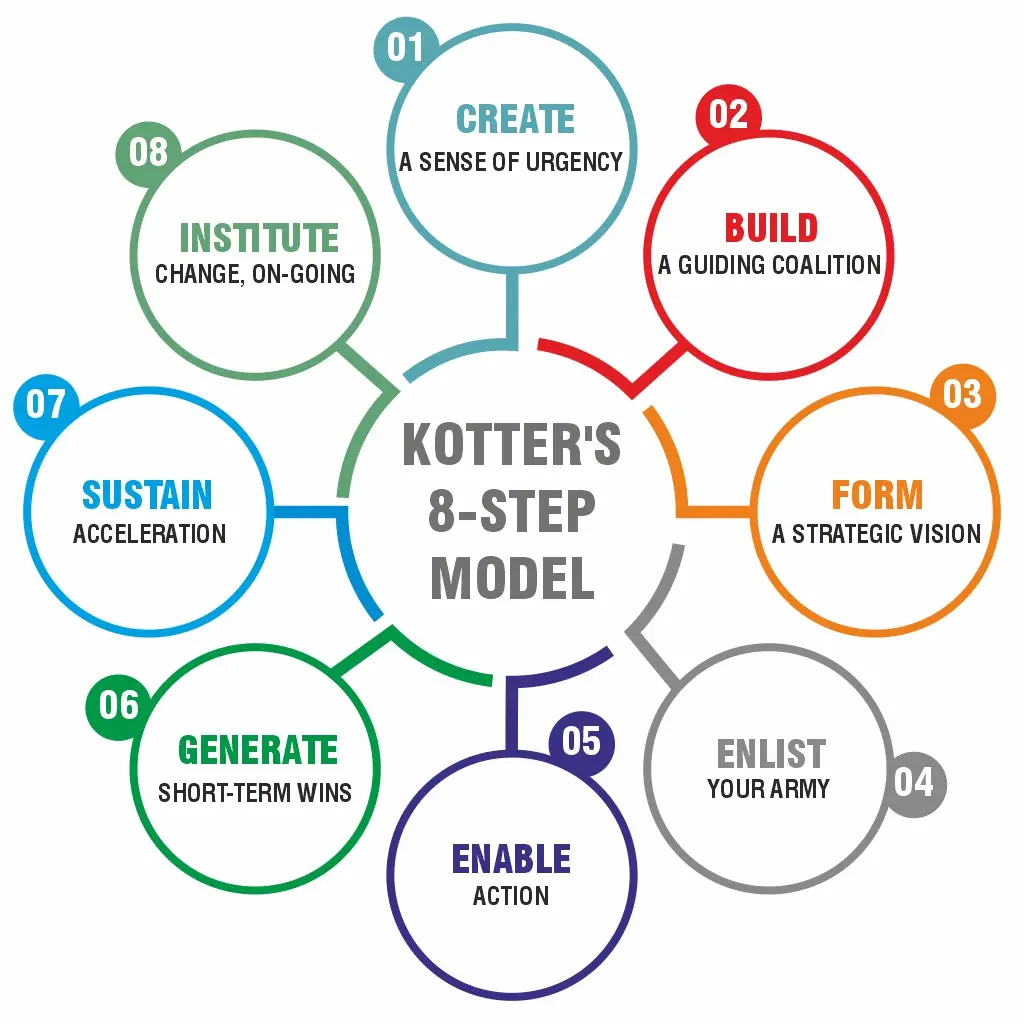🏢 9,000+ Organisations
🏆 6 x L&D/HR Awards
⭐ 4.8/5 Highly Rated
🧠 24 Years' Experience

Ever heard of the Kotter Change Model? It’s one of the most popular approaches to managing change.
The ability for managers to lead change has become one of the most fundamental skills In today’s business world. Whilst it can sound like a daunting task, with the right tools and approach, it can be done successfully… step forward Dr. John Kotter and his 8 step model!
Used by organisations of all shapes and sizes, Kotter’s change model is considered to be a massive success for its simplicity, practicality, and ultimately, the results it gets when navigating the complex process of change management.
Let’s take a deeper look at Kotter’s 8 steps, and explore how you can put them into action and effectively implement change within your organisation.

Dr. John Kotter is an American management consultant and author. His work has been influential across the leadership and management field and he is credited for being one of the most important thought leadership thinkers of our time. Kotter’s theory is widely used on the majority of change management training courses that are run.
Kotter is currently the Konosuke Matsushita Professor of Leadership at Harvard Business School where he has taught for over 30 years. He is Chairman of Kotter International, which he co-founded in 2008, and he acts as a management consultant where he applies his research to help organisations transform and execute large scale changes.
He has also written several books, including, “Our Iceberg is Melting: Changing and Succeeding Under Any Conditions”, “Accelerate: Building Strategic Agility for a Faster-Moving World” and “Leading Change”. “Leading Change” is considered a classic in the field of organisational change and is where Kotter’s 8 step model for leading change is introduced…

The first step in Kotter’s 8-Step process for leading change is to create a sense of urgency within your organisation. Kotter presents that in order to create change, there’s a requirement to build a sense of urgency around the “need for the change” itself amongst employees.
One way of driving urgency is by communicating the clear vision of the future and highlighting any potential threats that could hinder that future. This will naturally encourage all employees to take action and to tackle any issues standing in the way.
On the flip side, another way to encourage urgency is to highlight the consequences of not making the changes within your organisation. For example, by not doing XYZ, the organisation will not be able to keep up with competitors. This reverse psychology approach is a sure fire way to light an urgent flame under anyone’s butt – because who wants to come second or to miss out on success?
Essentially, the main objective of this step is to inspire and mobilise employees into rapid formation. To get them battle ready and prepared to take action on the change initiatives now rather than later.
The next step in Kotter’s change model involves pulling together a group of stakeholders who hold sufficient power and influence around your organisation to guide and lead the change.
The main role of the coalition is to support the change. To push its direction forward. They become the lieutenant’s of change implementation, removing any obstacles, and eliminating any resistance across the organisation.
Kotter suggests that ideally the coalition should be a diverse mix of employees and that the members should be represented by different levels and areas. Additionally, and this goes without saying, all members should be able to get along with each other. That’s because it will only improve the most important part of the Guiding Coalition – everyone being on the same page and committed to change!
The importance of this step allows you to produce an alliance of employees that can come together and become a force committed to supporting your vision as a leader and helping to drive change forward.
Having a strategic vision can help to provide clarification on the difference between the present and the future – where do you want your organisation to end up? This step in Kotter’s model is crucial to the process of change management as it sets the foundations for the entire plan.
The strategic vision should be a compelling picture of what needs to be achieved and what the desired outcome of the organisation will look like in the future after change is implemented. It should be ambitious but achievable, and be motivating and inspiring for everyone in the organisation to understand and follow.
It’s key to note that this step is not just about simply putting together a strategic vision, but also involving everyone in the organisation in the construction of it. By involving employees in the process of creating a vision, you will naturally endorse a commitment to it and get buy-in from the get go. Afterall, the vision will become the guiding principle for everyone within the organisation and help to align the actions of all employees towards achieving the desired outcome. So get them involved!
Enlisting a volunteer army is essential to driving change within your organisation. This is because power really does come in numbers!
The 4th step in Kotter’s model highlights how large-scale change can only occur when massive numbers of people rally behind a common opportunity. An army of unified employees who all share the same pursuit of reaching a goal collectively. Sounds powerful right?
To effectively enlist an army you must first identify potential allies and build relationships with them. This can be done through open communication and by involving them in the change process from the beginning. Additionally, another method of enlisting and growing an army is to reward individuals for their contributions and support. This will build morale and motivation, and will organically encourage others to get involved.
If you can get as many people as possible behind the change requirements and rally up a troop of employees who collectively are passionate about the change, then you will have a stronger chance of making it a success!
As much as having a strong army of employees advocating change sounds like a force to reckon with, it’s just as vital to tackle any obstacles that might slow them down!
Kotter emphasises in this step the importance of identifying and clearing the way for your employees to work more innovatively. Quite simply, this step involves identifying and addressing any obstacles that may be preventing the implementation of change initiatives. These barriers can be internal or external, and can come in the form of processes, systems or even people.
Removing barriers is a continuous process that requires ongoing monitoring, and be prepared for obstacles that will arise frequently! Which is why it’s important you have your Guiding Coalition and Volunteer Army cemented firmly in place. They can aid in the removal of obstacles and keep you firmly on the path to your vision.
By taking this step, you can eliminate anything that can slow you down or block progress and the road to change within your organisation will be a smoother journey!
Tying in with Kotter’s steps so far, generating short term wins can help you and your employees keep momentum. They help to create a sense of progress whilst working towards change implementation and your endgame vision.
What comes to mind here is training for a marathon – with no past experience of running! You wouldn’t head out the door and race to the finish line? You would break it down into bite-sized distances and aim to hit each milestone, treating it as a win and then moving on to the next distance until you can complete the full marathon. Every individual checkpoint is vital to getting to the bigger picture and the end goal and should be celebrated as such.
As a leader, it would be your role to establish the short-term wins which requires careful planning and execution. You should identify specific, measurable goals that can be achieved within a relatively short time frame (such as three to six months).
By creating these small, measurable goals along your journey to change, Kotter identifies that they can ensure your employees’ efforts are making a difference. Ultimately meaning they are more likely to continue working towards that larger vision, and providing some proof to anyone opposed to change that you are on the right track and it can be achieved.
Now that you have your army, your short term checkpoints to hit, and your long-term vision, it’s important to keep things going!
Kotter’s 7th penultimate step, focuses on maintaining the momentum utilising the previous steps and ensuring the change keeps moving forward. You’ve come so far, you don’t want it to fizzle out?
One key aspect of this step is to encourage employees to identify and address any issues that arise and to continuously seek out ways to improve the change initiative. From the back of this, another element is to make sure you have a reward system in place to recognise those employees who have successfully implemented change and are working hard to make it a reality. Providing recognition to those that have helped achieve a short term win can serve as a powerful tool for motivating others to join the movement and to support the change. Who doesn’t want kudos?
Sustaining acceleration is a critical step in the change management process, as it ensures that the change initiative becomes a permanent part of your organisation’s culture.
The final step of Kotter’s change model is to make change stick! To embed a new way of working and develop a new culture that makes change a permanent part of your organisation rather than just a quick fix.
This last step is crucial in ensuring that the changes made through the change management journey are sustained and have longevity. The ultimate aim is to ensure that change becomes an integral part of your organisation and becomes recognised by all employees. As a leader it is integral that you work to create this culture of continuous improvement and keep encouraging employees to identify and address any issues that arise along the way.
Fundamentally, when you reach this step, whether it’s your first or hundredth time, you would conclude and consolidate the gains made so far – hurray! – and then go on to produce even more change. This way your organisation becomes an ever revolving wheel of agility, success and progression into the future. Exciting stuff!
It’s important to recognise if Kotter’s model is right for you and your organisation, so let’s take a look at some of the advantages of using it:
And with any model, it also comes with its limitations. Some of the disadvantages of using Kotter’s change model are:
Kotter’s 8 step change model is a valuable and powerful framework for leading change in organisations.By following each step, you can create a sense of urgency, involve key stakeholders, ensure sustainability, and really drive change within your organisation.
Whilst change is not a one-size-fits-all process and there are some drawbacks to Kotter’s model, as a leader, you should be prepared to adapt. Change is a continual process, so make adjustments as and where needed to achieve your desired vision and make navigating the complex process of change management a success.
Kotter’s model is covered in greater detail on the Management Training Courses that we run around the UK and on the bespoke Management Development Programmes that we create for our clients.
Please Contact Us to discuss your requirements.

Written by Sean McPheat
CEO of MTD Training and Amazon bestselling author. Sean writes about leadership, business, and personal growth, drawing on 20+ years of experience helping over 9,000 companies improve performance.
Updated on: 18 January, 2023
Related Articles

Search For More 